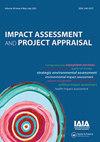更深入地理解环境影响评价(EIA)中重要性判断的心理学基础
IF 1.9
4区 社会学
Q3 ENVIRONMENTAL STUDIES
引用次数: 1
摘要
重要性判断是环境影响评价的核心,为总体决策提供了依据和理由。尽管显著性判断的主观性质得到了广泛认可,但旨在更深入地理解其含义的研究有限。本文建立在不断增长的传统之上,即探索从心理学中学习,以应对环评实践中的挑战,在这种情况下,即显著性判断。因此,本研究的目的是更深入地理解支撑意义判断的心理学。这是通过将心理学的10个概念应用于“显著性谱模型”的四个步骤来实现的,即:决定阈值、做出预测、判断可接受性和考虑缓解。结果表明,显著性判断应该(括号中提供了心理学的基本概念)针对有限数量的关键阈值(选择悖论);考虑到未来收益(损失厌恶)设计阈值,重新考虑概率评分(可能性和确定性效应);避免基于有限信息的判断(What You See Is All There Is,WHYSIATI);利用统计预测而非专家意见(专家谬误);仔细沟通(启动、框架和认知轻松);并考虑个人态度和偏见(影响启发式)。本文章由计算机程序翻译,如有差异,请以英文原文为准。
Gaining a deeper understanding of the psychology underpinning significance judgements in environmental impact assessment (EIA)
ABSTRACT Significance judgements lie at the heart of EIA and provide the basis and justification for overall decision-making. Although the subjective nature of significance judgements is widely recognized, there has been limited research aimed at gaining a deeper understanding of its implications. This paper builds on the growing tradition of exploring learning from psychology in dealing with challenges in EIA practice, in this case, significance judgements. The aim of this research is therefore, to gain a deeper understanding of the psychology underpinning significance judgements. This is achieved by applying 10 concepts from psychology to the four steps in the ‘significance spectrum model’, namely: decide thresholds, make predictions, judge acceptability and consider mitigation. The results suggest that significance judgements should (with underpinning concepts from psychology provided in parentheses) aim for a limited number of key thresholds (paradox of choice); design thresholds with future gains in mind (loss aversion), reconsider probability scoring (possibility and certainty effect); avoid judgements based on limited information (What You See Is All There Is, WHYSIATI); utilise statistical prediction over expert opinion (expert fallacy); communicate carefully (priming, framing and cognitive ease); and consider personal attitudes and biases (affect heuristic).
求助全文
通过发布文献求助,成功后即可免费获取论文全文。
去求助
来源期刊

Impact Assessment and Project Appraisal
ENVIRONMENTAL STUDIES-
CiteScore
4.60
自引率
22.70%
发文量
52
期刊介绍:
This is the international, peer-reviewed journal of the International Association for Impact Assessment (IAIA). It covers environmental, social, health and other impact assessments, cost-benefit analysis, technology assessment, and other approaches to anticipating and managing impacts. It has readers in universities, government and public agencies, consultancies, NGOs and elsewhere in over 100 countries. It has editorials, main articles, book reviews, and a professional practice section.
 求助内容:
求助内容: 应助结果提醒方式:
应助结果提醒方式:


